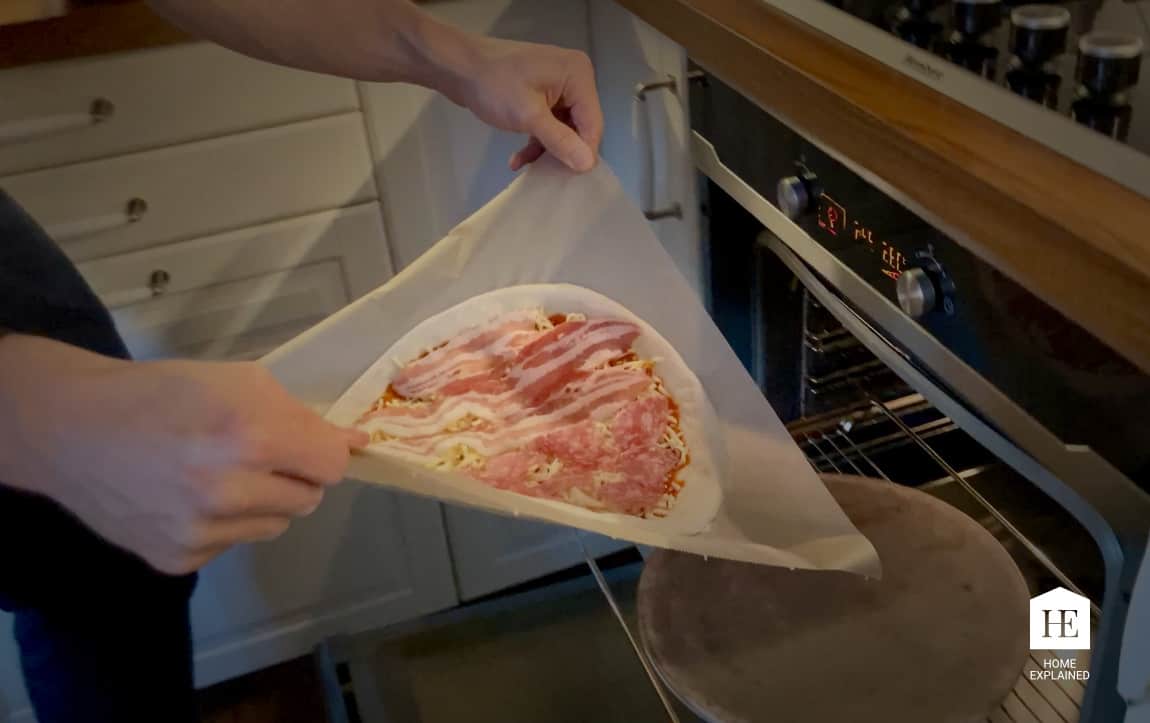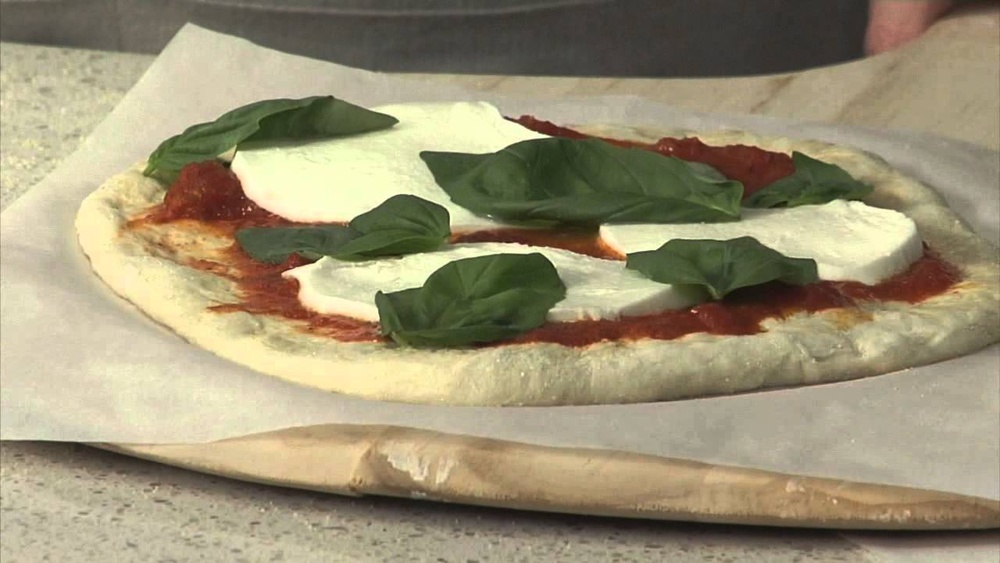You love the crispy, golden crust that a pizza stone can give your homemade pizza. But what if you don’t have a pizza peel to slide your pizza onto the stone?
Don’t worry—you can still achieve that perfect bake without one. You’ll discover simple, practical ways to use your pizza stone safely and easily, even if you’re missing this common tool. Keep reading, and you’ll learn how to make restaurant-quality pizza right in your kitchen, no peel needed.
Choosing The Right Pizza Stone
Choosing the right pizza stone is important for baking delicious pizzas at home. The right stone helps cook the pizza evenly and creates a crispy crust. Knowing what to pick makes the baking process easier and more fun.
Material Options
Pizza stones come in different materials. Ceramic stones are common and affordable. They hold heat well but can crack if dropped. Cordierite stones are stronger and resist thermal shock. They last longer and heat evenly. Soapstone stones absorb heat slowly but keep it steady. Choose a material that fits your budget and cooking style.
Size And Thickness
The size of the stone should fit your oven and pizza. A stone too big may not heat well. Too small means your pizza might hang off the edge. Thickness matters too. Thicker stones hold heat longer but take more time to warm up. Thin stones heat faster but cool down quickly. Pick a size and thickness that match your baking needs.
Prepping The Stone
Before using a new pizza stone, clean it with water only. Avoid soap or detergent. Let it dry completely to avoid cracks. Heat the stone in the oven slowly to prevent damage. Do not add oil or spray on the surface. Proper prepping helps your stone last longer and bake better pizzas.

Credit: homeexplained.com
Preparing Your Workspace
Preparing your workspace is an important step before using a pizza stone without a pizza peel. A clean and organized area helps you handle the dough and stone safely. It also makes the process smoother and faster. Setting up everything you need nearby saves time and prevents accidents.
Keep your work surface clear. Make sure you have enough space for the dough, tools, and the pizza stone. This preparation reduces stress and helps you focus on making a perfect pizza.
Clearing And Organizing
Start by clearing your kitchen counter or table. Remove any items that do not belong to the pizza-making process. Arrange your ingredients, utensils, and tools neatly. Leave enough room to roll out the dough and slide the pizza onto the stone. A tidy workspace helps you work faster and avoid mistakes.
Using Parchment Paper
Parchment paper can act as a helper when you don’t have a pizza peel. Place your rolled dough on a sheet of parchment paper. Add toppings directly on top. The paper allows you to slide the pizza onto the hot stone easily. It also prevents sticking and helps with cleanup.
Alternative Tools To A Pizza Peel
Look around your kitchen for tools that can replace a pizza peel. A flat baking sheet or an upside-down cutting board works well. Make sure the surface is smooth and dry. Use these tools to transfer your pizza safely. They help you avoid burns and keep the pizza intact.
Transferring Pizza Without A Peel
Transferring pizza onto a hot pizza stone can be tricky without a pizza peel. It requires a steady hand and some simple tools. Using alternatives helps move the pizza safely and keeps its shape intact. Below are easy ways to transfer your pizza without a peel.
Using A Baking Sheet Or Tray
Place your shaped pizza dough on a flat baking sheet or tray. Lightly dust the surface with flour or cornmeal to prevent sticking. Slide the pizza off the tray directly onto the hot stone. Hold the tray close to the stone’s edge and give a quick push. This method offers good control and reduces mess.
Sliding Pizza With Parchment Paper
Roll out your pizza dough on a piece of parchment paper. The paper acts as a base for easy sliding. Lift the paper with the pizza and place it onto the stone. Parchment paper withstands high heat and helps keep the pizza intact. After a few minutes, gently pull the paper out from under the pizza to let it cook directly on the stone.
Flour Or Cornmeal Tricks
Sprinkle plenty of flour or cornmeal on the work surface before shaping dough. These dry ingredients create a barrier that stops dough from sticking. This makes sliding the pizza onto the stone easier. Shake the peel or tray gently to loosen dough before transferring. A light dusting goes a long way in smooth pizza transfers.

Credit: www.crustkingdom.com
Cooking Tips For Perfect Pizza
Cooking pizza on a stone without a peel can be easy with the right tips. The stone helps make a crispy crust and cooks the pizza evenly. Knowing how to use it properly saves time and improves your pizza’s taste. Follow these tips for the best results.
Preheating The Stone
Place the pizza stone in a cold oven. Set the oven to a high temperature, about 475°F (245°C). Let the stone heat for at least 30 minutes. This ensures the stone is hot enough to cook the pizza crust well.
Monitoring Cooking Time
Check your pizza often while it cooks. Cooking time is usually 10 to 15 minutes. Look for a golden crust and melted cheese. Remove the pizza when it looks ready to avoid burning.
Avoiding Sticking
Sprinkle cornmeal or flour on the stone before placing the dough. This helps the pizza slide easily and stops it from sticking. Use a flat, sturdy spatula to lift the pizza gently when done.
Removing Pizza From The Stone
Removing pizza from a hot pizza stone without a peel can feel tricky. The stone holds the pizza firmly while it cooks. Care is needed to lift the pizza without breaking it or burning yourself. A few simple tools and careful steps make the process smooth and safe.
Using Tongs Or Spatula
Use a pair of long tongs or a wide spatula to lift the pizza gently. Slide the spatula under the pizza crust from the edge. Move slowly to avoid tearing the crust or dropping toppings. Tongs can help hold the pizza steady while you slide the spatula underneath. Always wear oven mitts to protect your hands from heat.
Cooling And Serving
After lifting the pizza, place it on a wooden board or heat-safe plate. Let it cool for a few minutes. This helps the cheese set and makes slicing easier. Avoid cutting the pizza directly on the stone. Cooling also prevents burns and keeps the crust crisp.
Cleaning The Stone
Allow the pizza stone to cool completely before cleaning. Never use soap or detergent; it can absorb into the stone. Scrape off stuck food with a plastic scraper or brush. Wipe the stone with a damp cloth to remove crumbs. Let it air dry fully before storing. Proper care keeps the stone ready for the next pizza.
Common Mistakes To Avoid
Using a pizza stone without a pizza peel can be tricky. Many beginners make mistakes that ruin the pizza or damage the stone. Avoiding these common errors helps you bake better pizza every time.
Pay close attention to these mistakes. They affect your pizza’s texture, taste, and cooking time.
Skipping Preheating
Always preheat your pizza stone before placing the dough on it. A cold stone will cause the dough to stick and cook unevenly. Preheating allows the stone to reach the right temperature. This gives the pizza a crispy crust and cooks it quickly.
Using Too Much Topping
Too many toppings make the pizza soggy and heavy. The dough may not cook well inside. Use a moderate amount of sauce, cheese, and toppings. This helps the heat reach the dough and bake it evenly.
Not Using Enough Flour Or Cornmeal
Flour or cornmeal helps slide the pizza onto the stone easily. Without enough, the dough sticks to your hands or the surface. Sprinkle a good amount on your work surface and under the dough. This prevents sticking and makes transferring simpler.
Creative Alternatives To A Pizza Peel
Using a pizza stone without a pizza peel can feel tricky. Many people think the peel is a must-have tool. Yet, there are simple and creative ways to slide your pizza onto the stone without one. These alternatives keep your pizza safe and help you bake it evenly. They use items you likely have at home.
Cutting Board Hacks
A thin wooden or plastic cutting board works well. Lightly dust it with flour or cornmeal. This stops the dough from sticking. Shape your pizza on the board. Then, gently slide the pizza off the board onto the stone. Tilting the board carefully helps the pizza slide smoothly. Practice makes this method easier and safer.
Cookie Sheet Methods
Use a rimless cookie sheet or one with very low edges. Dust it with flour or cornmeal too. Assemble the pizza on the cookie sheet. Slide the pizza off the sheet onto the stone by tilting it. This method offers good control over the pizza. It also helps avoid messes in your oven.
Silicone Mats And More
Silicone baking mats can act like a peel. They provide a non-stick surface for your pizza dough. Dust the mat lightly before placing the dough. You can slide the pizza directly from the mat to the stone. Other tools like parchment paper can help too. Just be sure to remove paper quickly once baking starts.

Credit: www.youtube.com
Frequently Asked Questions
Can I Use Parchment Paper Instead Of A Pizza Peel?
Yes, parchment paper helps slide pizza onto the stone easily. It prevents sticking and makes transferring safer without a peel.
What Household Items Replace A Pizza Peel Effectively?
A flat baking sheet or a sturdy cutting board works well. Both provide a firm surface to slide pizza onto the stone.
How Do I Prevent Pizza From Sticking Without A Peel?
Dust your peel substitute with flour or cornmeal. This reduces friction and prevents dough from sticking during transfer.
Is A Pizza Stone Necessary For Homemade Pizza?
A pizza stone ensures even heat and a crispy crust. It mimics a traditional oven floor, improving pizza quality without professional tools.
Conclusion
Using a pizza stone without a peel is simple with a few tricks. Try using parchment paper or a baking sheet to slide your pizza. Always preheat the stone well for a crispy crust. Handle the stone carefully to avoid burns.
Practice makes perfect, so keep trying different ways. Enjoy fresh, tasty pizza right from your oven. No peel? No problem!

